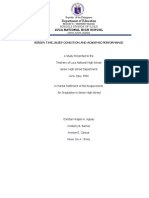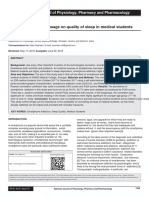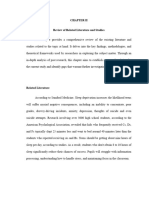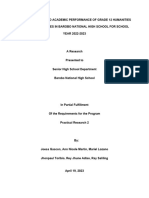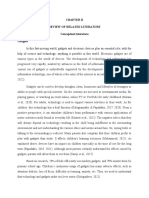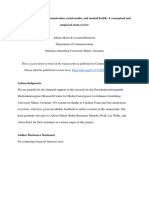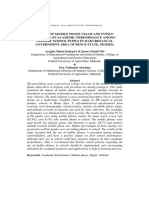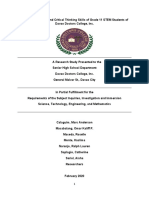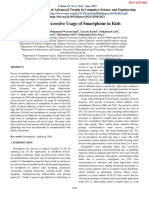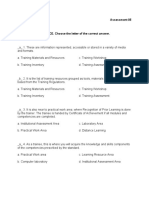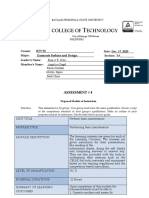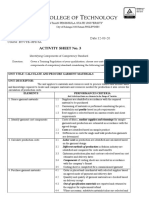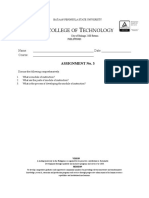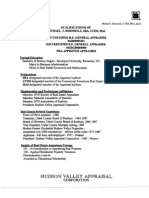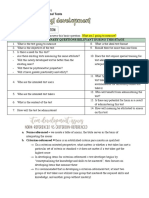The concept of the smartphone in mobile learning
Mobile learning (m-learning) is a mode of learning whereby mobile computing coupled
with wireless technology help learning to take place anywhere and anytime ( Asabere, 2013).
Naismith et al. (2004 as cited in Sarfoah, 2019, p.29 ) succinctly define mobile learning as
“learning which employs wireless devices like smartphone, PDA, iPod, palmtop, laptop or even
digital camera and USB keys in the learning and teaching process”. The smartphone is an
indispensable device in the area of mobile learning. The most crucial features of a smartphone
are its availability with users, strong battery, touch screen, millions of downloadable applications
(GodwinJones, 2011). According to Fordjour, Zakaria, and Afriyie (2015, p.1), a “smartphone is
a mobile phone with more advanced computing capability and connectivity than a feature phone
which has limited functionality”. Smartphones were released in the year 2000. It was first
manufactured by Ericsson and the model was called R380 (Alfawareh & Jusoh, 2014).
Smartphones support learning either offline or online. Offline access enables users of
smartphones to store any form of learning materials such as pdf, powerpoint, word, excel,
pictures, animations, symbols; irrespective of the geographical location. Internet access is
needed for learners like students and teachers to visit websites to meet their information needs.
The exploration of the smartphone has changed the dynamic of students learning activities. It is
refreshing to note that, 8 students can carry a whole semester’s learning materials on a small
smartphone which gives students the latitude to learn in an area which, on a normal
circumstance, will require a laptop or other related form of a computer. For instance, a student
can access their lecture materials whiles in a car, train, plane, and marketplace to mention but a
few. It also enables students to register courses online, take a quiz or semester through the use
of an assigned or registered learning management system, and can have a group discussion
digitally.
Smartphones usage in Distance Education.
It is obvious that mobile learning can be considered as the central hub to enhance
distance education. Tegoe (2014, p.1 ) concur that “Distance education has always grown on
the wings of technology. Tuncay, N. (2016) postulated in the study that focused on smartphones
as tools for distance education: “Needs of students become so sophisticated that they refuse to
carry heavy weight laptops or books, and they save everything in their phones”. Ketheeswaran
and Mukunthan ( 2016) investigated the usage of the smartphones for learning purposes by
students who pursue ‘Diploma in Commonwealth Youth Development Programmes’ in the
Colombo And Batticaloa Centres of the Open University of Sri Lanka K. The study revealed that
“the usage of smartphones related with distance education helps to increase students learning,
social interactions, collaborative learning, and socialization of students, etc. It was postulated in
the same study that “in the coming decade smartphones will be a main learning tool in the
distance learning system” ( 2016, p.1 ). Tegoe (2014) revealed that there is a high rate of the
adoption of mobile learning across the globe and there is evidence in developing countries
�complementing mobile learning to its convention mode of teaching and learning. In effect, this
has enhanced distance education programs been offered by higher education.
Students’ Perceived Ease of Use of Smartphones in Learning Activities.
“Perceived ease of use (perceived complexity) has been found to be an important
determinant of technology usage, both in a direct and indirect manner, and technology users
have been proven to attempt to minimize their cognitive effort on their behaviors” (Cho, 2011).
The author further concluded that individually students develop the intention to use
smartphones in their learning activity, if it is perceived to be easy to use. Ifeanyi and Chukwuere
(2018) revealed that most of the respondents 269 (71.7%) concur that, they sometimes find it a
daunting task accessing academic material on their smartphones. Consequently, it affects their
academic performance. This findings support the study of Sarfoah (2017) in which it was
revealed that, most respondents strongly disagree to the statement that “I find smartphone
learning easy.” This is an indication that, the students did not find it comfortable using a
smartphone as a supplement tool for learning. On the other hand, Iqbal and Bhatti (2015)
investigated University students’ readiness towards Mlearning using Technology Acceptance
Model in Pakistan and it was brought to bear that, students possess the right skills to use mobile
learning; they will find it easy to use a smartphone; and this also enhances their perceived
usefulness of using smartphone for learning activities.
Common health effects
Though it is known that there could be numerous causes of headache; stress of studies and
daily travel as well as exposure to pollutants, being a few important ones, yet in this study the
perceived view of the respondents was acceptable. Suitable literature on this specific symptom
and implications of cell phones for the same could not be homed onto. More research is needed
to corroborate this fact.
Anxiety is a displeasing feeling of fear and concern. Subjects complained of performance-related
anxiety, especially on performing well in exams, so as to get better opportunities. Most mobile
addicts are people with low self-esteem and are prone to develop friction in their social relations.
They feel the urge to be constantly connected and in contact with others and if they are deprived of
their cell phones, regardless of the reason they become anxious and irritable. The fact is stated in
Francisca Lopez’s study [7].
It was observed that continuous usage, staring at the screen caused the subjects eye strain so much
so that some of them had to go to a Doctor for an eye checkup. However none were diagnosed with
a refractive error or other serious eye ailments. Eye strain is obvious due to focusing on the screen
or due to continuous texting and playing games. The same is mentioned by the Center on Media and
Child Health in their article “Cell Phones” [4]. Another study by the International Commission on non-
ionizing radiation protection (April 1998) reports that “premature cataracts” are not linked to cell
phone use due to lower power output of mobiles [1].
�Other indicators of physical health
The potential impact of excessive mobile device use on other factors of physical health,
particularly musculoskeletal pain and discomfort, headaches, and eye strain, has become a
concern for researchers and clinicians. Phone use, specifically, has been linked to increased
neck and back pain (Kim & Koo, 2016), eye strain (Acharya, Acharya, & Waghrey, 2013), and
increased risk for headaches (Wang, Su, Xie, & Yu, 2017). However, studies have primarily
concentrated on adult populations and few studies thus far have investigated these physical
health outcomes as they relate to excessive mobile device use in youth. Using the parameters
of this current search, eight studies were identified as investigating the impact of phone use on
other indicators of health.
Musculoskeletal and pain complaints. Our literature search yielded four cross‐sectional studies
that examined the association between phone use and musculoskeletal pain and discomfort. Of
the four, two studies (Palmer, Ciccarelli, Falkmer, & Parsons, 2014; Shan et al., 2013)
investigated pain complaints and two studies investigated posture during tablet use in youths
(Howie, Coenen, Campbell, Ranelli, & Straker, 2017; Straker et al., 2008). Of the two studies
investigating pain complaints, one (Shan et al., 2013) found that a period of mobile phone use
longer than 2 hr per day was related to significant increase in the prevalence of reported lower
back pain and neck and shoulder pain among youth. In contrast, Palmer et al. (2014) found no
relationship between phone exposure and self‐reported discomfort (however, this study had a
small n). Two studies investigated postural differences during real‐time use of technology.
Straker et al. (2008) found that greater muscle activity and asymmetry in the trunk and
shoulders during tablet use compared to desktop computer use. Another study found that
children displayed greater mean head, trunk, and upper arm angles while using a tablet than
while playing with toys or watching television (Howie et al., 2017).
Given the small number of studies investigating musculoskeletal pain and discomfort, limited
generalizations can be made. For example, one study (Shan et al., 2013) asked questions
specifically about other factors relevant to phone behavior and posture (e.g., the eye‐to‐
computer screen distance, height from screen, and duration of use), whereas Palmer et al.
(2014) assessed total hours spent on phone regardless of activity.
�https://digitalcommons.unl.edu/cgi/viewcontent.cgi?article=6260&context=libphilprac
https://www.omicsonline.org/a-study-on-some-of-the-common-health-effects-of-cell-phones-
amongst-college-students-2161-0711.1000214.php?aid=14036
https://onlinelibrary.wiley.com/doi/full/10.1002/hbe2.145

